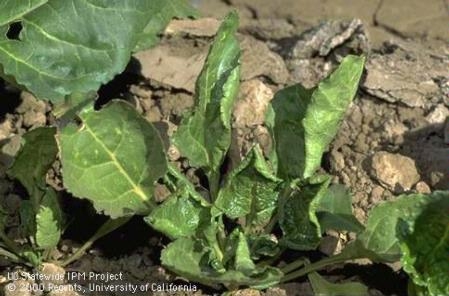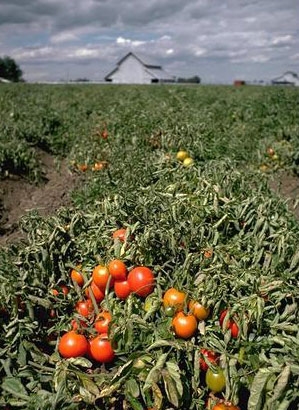Posts Tagged: tomatoes
Crop diseases a concern in strawberries and tomatoes this year
Record reporter Reed Fujii spoke to Brenna Aegerter, UC Cooperative Extension advisor in San Joaquin County. She said she's never seen such losses due to beet curly top virus.
"In my eight years here in this county, I had only seen curly top in two fields," she said. "The virus was present in every tomato field I have seen this season, though in most fields, the incidence was so low as to not be a concern."
Beet curly top is spread by beet leafhopper. The insect don't like tomatoes and peppers, but will briefly feed on the crop and infect them before moving on, Aegerter said. The high leafhopper population is most likely a cyclic peak.
"The hope is we'll go back next year to not seeing it," Aegerter said.
Amy Asman of the Santa Maria Sun used UC Cooperative Extension materials for her story on the serious pallidosis-related disease threat in local strawberries. For detailed information about the strawberry decline, see UCCE advisor Surendra Dara's story in the Strawberries and Vegetables blog.
Inter-planting Fruit Trees With Veggies
Yes, you can have it all in a relatively small back yard space: Fruit trees and veggies. Our “mini orchard” is on an oblong plot that’s about 25x15’, a sunny plot that came with the house we bought last summer. In that space there are 3 dwarf plums (Prunus spp.), 2 apricots (P. armeniaca), 3 cherry trees (P. avium), 2 peach trees (P. persica), and an apple (Malus domestica), all of unknown varieties. Our fruit trees are about 5 or 6 year old mostly dwarfs (I think), and if not, they got dwarfed anyway by my pruning saw and loppers last December, when I pruned both for shape and fruit production. My rule of thumb with fruit trees is that if it is higher than I can reach, it gets lopped off. This permits easy picking of the fruit and avoids the need for ladders. The pruning and thinning of the foliage, which I do about once per month (see photos) also allows more nutrients to get to the fruit, besides giving those veggies planted in between their 6-8 hours of sun.
The veggies we have include 6 tomato plants (Solanum lycopersicum) in cages, 2 clumps of squashes (Curcurbita pepo), Japanese eggplant (Solanum melongena), bell peppers (Capsicum annuum), a lemon cucumber (Cucumis sativus), 3 hollyhocks (Alcea setosa), and 2 sunflowers (Helianthus annuus). The tomatoes have been so productive we have to give the surplus to neighbors and friends. The eggplant and peppers have been slower to mature but nonetheless very tasty in stir-fries, especially with added portabella mushrooms (Agaricus bisporus) and fresh chard (Beta vulgaris), the chard grown in one of our raised beds in another location of the yard.
And so, another example of when less (space) is more (more intensively gardened).
UC Davis has a publication called The California Backyard Orchard, which you may find useful for tips on pruning, both in the dormant season in during the spring and summer months. See homeorchard.ucdavis.edu.
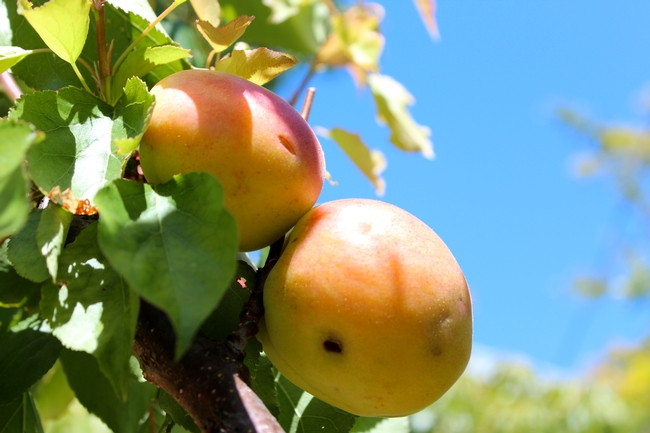
Apricot. (photos by Bud Veliquette)
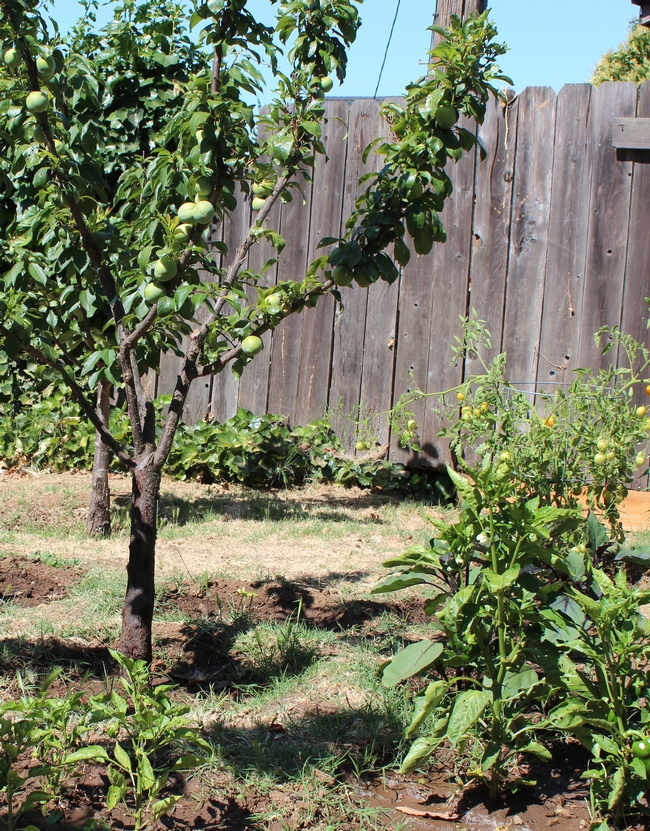
Apple tree, peppers and tomatoes.
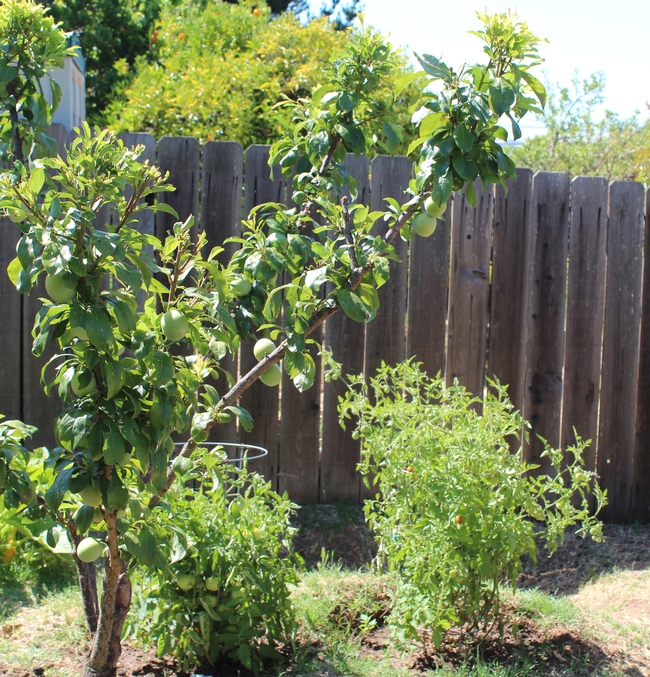
IMG 1082
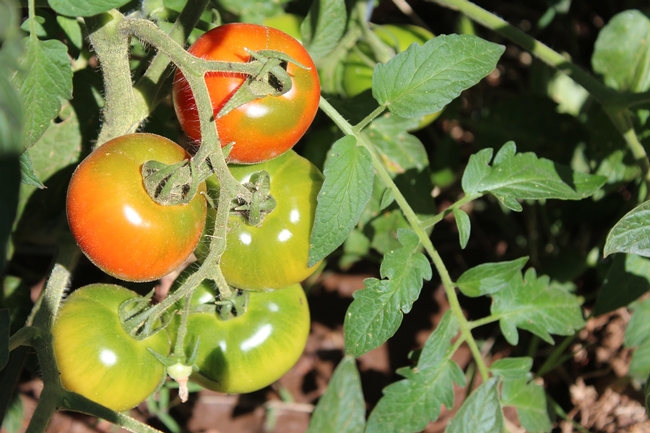
Vine-ripening tomatoes.
Japanese Tomatoes
A few weeks ago I was browsing through the nursery at a farm in Vallejo and saw a tomato plant that was just labeled with a “J” on the pot. I questioned farmer Rita about it and she told me it was a Japanese tomato plant she grew from a packet of seeds she found at a market. Never having heard of a Japanese tomato before, I couldn’t resist the urge to buy it and plant it in my garden just out of curiosity.
After planting it, I started researching my new Japanese tomato plant. I should have known there would be countless varieties of Japanese tomato plants. But three plants appear to be popular among California gardeners.
- Momotaro
The Momotaro tomato, both the heirloom and the hybrid varieties, seems to be the most popular Japanese tomato grown in the state. Extremely popular in Japan, this indeterminate plant grows five feet tall and produces thick skinned rose pink meaty tomatoes. The average tomato weight is six to seven ounces. There is also a yellow Momotaro variety. Named after a Japanese folk hero, the taste of this low acid tomato is frequently described as both sweet and tangy.
- Odoriko
Another indeterminate tomato plant that also produces low acid pink fleshed tomatoes is the Odoriko. The heirloom Odoriko is listed as one of the top ten best tasting heirloom tomatoes in issue #88 of Fine Gardening magazine, while the hybrid Odoriko is listed in an article on the Sunset website on their favorite slicing tomatoes. Some gardeners also report the tomatoes are slightly larger in size than the Momotaro.
- Mandarin
Producing orange-yellow tomatoes, the indeterminate Mandarin tomato plant is another heirloom Japanese tomato. The average tomato weights six to ten ounces. Mandarin tomatoes add a nice color variety to garnishes and salsa recipes.
Although the three plants just mentioned produce pink or orange-yellow flesh tomatoes, there are a number of popular red fleshed tomatoes like the Katana tomato. But little information is available as to whether or not this red tomato grows well in California.
An additional frequently grown tomato plant often referred to as a Japanese tomato is the Japanese Black Trifele, aka the Japanese Black Truffle. Known as one of the darkest colored black tomatoes, it is actually of Russian origin, not Japanese.
Although I have no idea if my Japanese tomato plant is one of the three popular ones often grown in California, I can’t wait until the tomatoes ripen on the plant. It will be fun determining what variety the tomato is, and tasting a tomato I’ve never tried before!
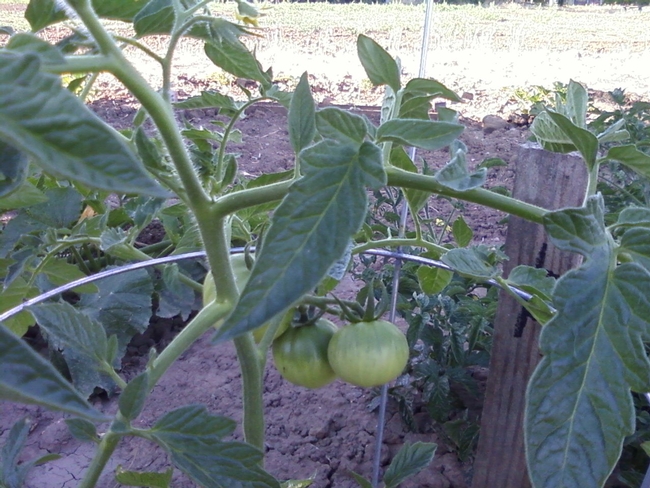
japanese tomato plant
Processing tomatoes facing a critical threat: curly top
Daniel interviewed Tom Turini, UC Cooperative Extension advisor in Fresno County. He said it's common to find some tomatoes infected with curly top, but this year is much worse than usual. The virus is transmitted by beet leafhoppers, which in dry years arrive early from coastal foothills and infect a bigger swath of cropland.
Fresno county has about 100,000 acres of processing tomatoes. Some fields have been completely lost.
"It is likely we're going have lower production in this area, which does account for over a third of California processing tomato production," Turini said.
Listen to the report here:
For more on curly top virus, see the UC Pest Management Guidelines for the disease.
Sorry Ladies!
Back in February, I wrote a blog that was a bit of a love letter to our three hens. Today we planted our tomatoes, so the love story has, sadly, come to a screeching halt.
This year’s tomatoes went into one of two raised beds, which have sat fallow for two years. I have always had to create a “dome of protection” with bird netting over the raised beds, as they abut a large open space where coveys of hungry quail lurk. And now we have to worry about our hens raiding the garden boxes, too.
Bird netting is hateful stuff. It catches on everything — branches, leaves, earrings, eyelashes. We wanted to make our lives easier, when it comes to bird netting, by building semi-permanent frames onto which we could wrap netting. I found a thorough online description for building PVC frames, and the construction began.
Our two raised beds are 4 feet by 10 feet. We started out making one rectangular frame to fit over the top of the beds. This was unwieldy to build, and would be too heavy and wobbly to move out of the way for harvesting and such. My husband decided to construct two frames, 4 feet by 5 feet each, and they went together much more easily. The beauty of two frames is they’re light. I can raise one half of the cover to harvest, add mulch or pull weeds. Knowing how tall indeterminate tomatoes can become, we plan to make two more frames that will stand taller. For now, the 3-foot height is fine.
Our hens are a bit miffed. They saw us put in the tomato seedlings this morning, and rushed over to gobble up those sweet new leaves. After much shooing and distracting with fresh, wormy piles of compost thrown their way, my husband and I were able to cover our new plants with our new frames. I’ll keep you posted on how well they work.
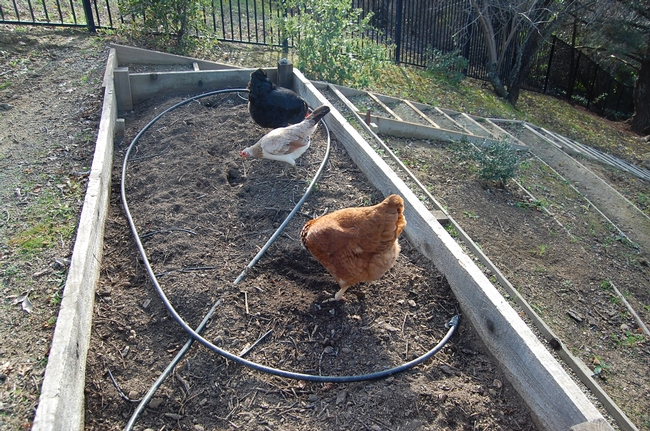
In February, our three hens were welcome to forage in the fallow raised beds. photos by Kathy Thomas-Rico
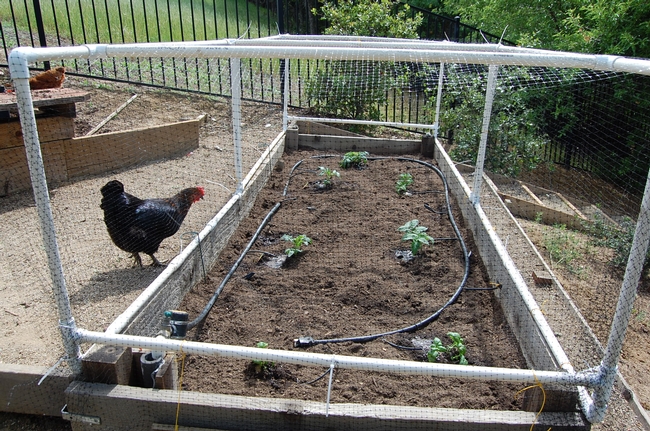
The newly planted bed, with new bird-netting frames, is no longer as welcoming to the hens and local quail.


